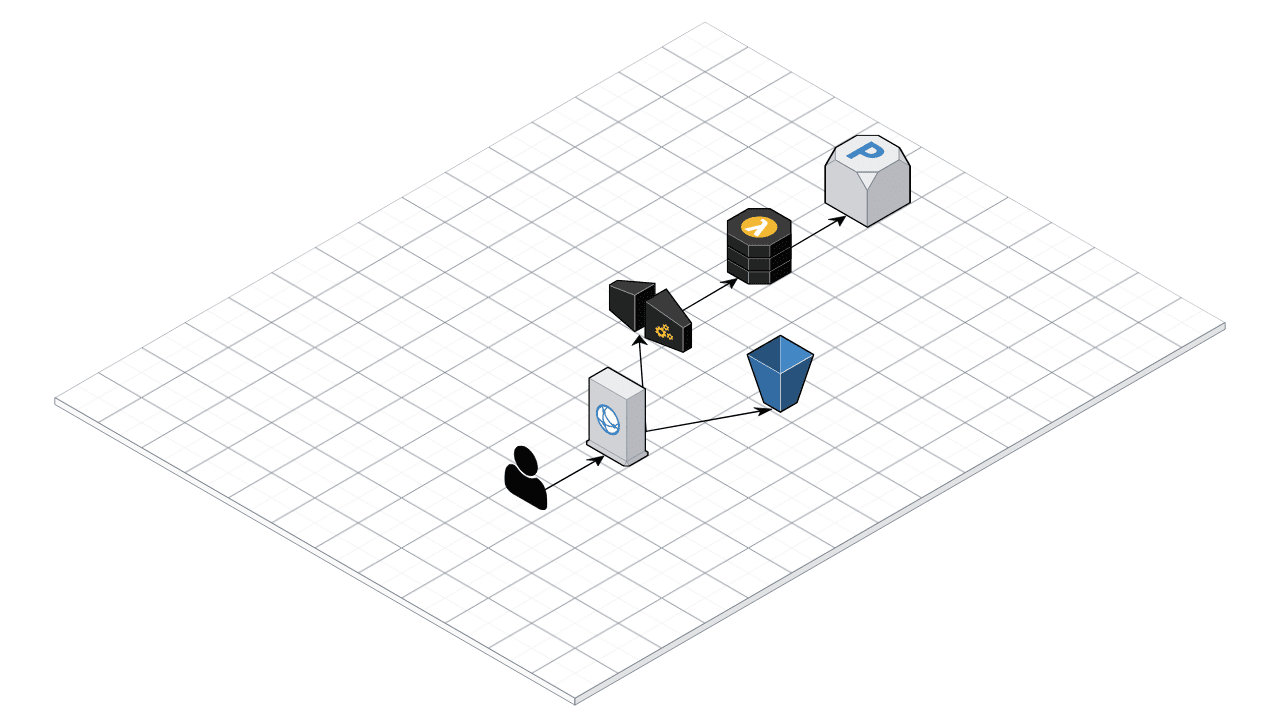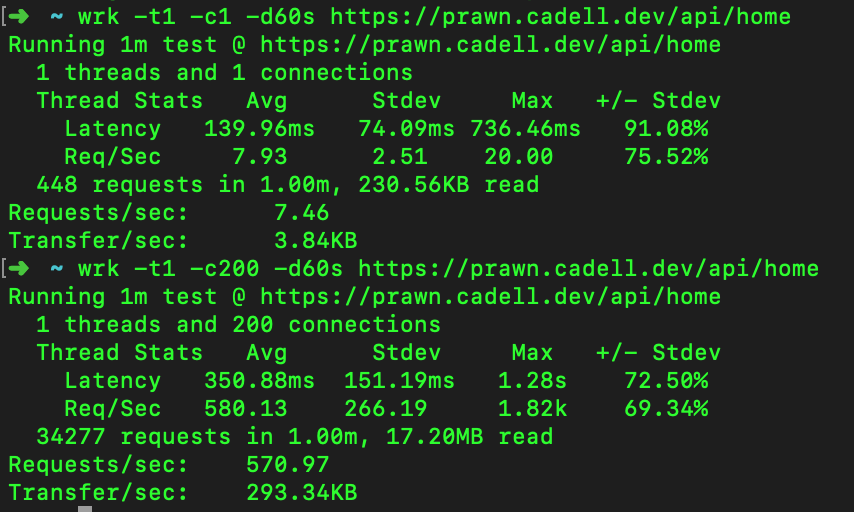🔗Page views: ...
🔗PRAwN Stack
🦐 🍤 🦐 🍤 🦐 🍤 🦐 🍤 🦐 🍤 🦐 🍤
A modern page view counter to see how unpopular my project is. Powered by a PRAwN stack (Postgres, React, AWs and Node) in the free tier, deployed using CDK.
- Postgres.
- React.
- Aws.
- Node.
We're also using Typescript and NextJS for the frontend.
🔗Features
- Relational database so you can make cool stateful apps like a page view counter.
- Fun local development experience with docker-compose.
- Easy to deploy with AWS CDK.
- Almost completely in the AWS Free Tier. Turns out this is actually quite difficult with RDS and Lambda.
🔗Design

🔗Performant Analytics with Rollups
We have a graph that shows the pageviews per hour and there's a few ways to make that happen.
- Calculate the aggregates when they're requested. This is the easiest and will be up to date but it can be slow and resource intensive if it's requested often.
- Setup a materialised view and refresh it on an interval. This is a natural extension of the first solution but will be much faster at the cost consistency because it might be stale. This also might be resource intensive if the table is big enough or the aggregates are complicated enough.
- Iteratively calculate the aggregates and store them manually. The materialised view solution might recalculate aggregates that aren't going to change because they might be in the past. E.g the pageviews for last month aren't going to change to why recalculate them. This is the approach we've taken here.
I would recommend starting with the first one then escalating to more complicated solutions as required but I wanted to explore the third solution with this project.
🔗Serverless and Lambda
I'm a serverless skeptic. A few timely things swayed me to try Lambda for this project.
- serverless-express allows you to run an express app in Lambda, which means you can run the express part locally for a nice development experience.
- I wanted to setup some cron jobs which are well suited to Lamdbda.
- AWS CDK makes working with AWS ~~easy~~ less hard.
It turns out the simplest way to setup Lambda with RDS is quite expensive. You have to use a NAT Gateway which costs $0.059/h and $44.25/month. That's expensive!.
There's a few ways to get around this:
- Make your database public. This isn't secure.
- Make your Lambda private so it can't access the internet. The internet is useful though and you'll have to pay to access AWS services like Secret Manager.
- Setup a NAT Instance in the free tier.
This all feels very typical of AWS.
I went with the NAT Instance because thankfully CDK makes it easy.
🔗Almost Completely in the Free Tier

The only thing you have to pay for is Secrets Manager which is $0.4/month.
There's also a budget configured with cdk to alert you when you spend more than $1 usd to remind you when the free tier ends.
After the free tier ends it will cost $40 usd/month.
🔗Load Testing

With more load, our application can support a throughput of 570 requests per second on average or about 49.2 million per day at 350ms latency. 350ms is still pretty fast and if we had a higher tolerance for latency then this stack could probably do more.
You can install wrk with:
brew install wrk
Then run it with:
wrk -t1 -c1 -d60s https://prawn.cadell.dev/api/home
If you want to go further with load testing then maybe have a look at vegeta, wrk2 or k6.
Load testing goes really deep apparently but I found How percentile approximation works (and why it's more useful than averages) was a good introduction to percentiles, as well as the hacker news comments, which is where I found How NOT to Measure Latency by Gil Tene, which is amazing! There's also an article similar to the talk but I much prefer the talk (and I don't usually watch talks).
Vegeta, wrk2 and k6 all avoid the coordinated omission problem mentioned in Gil's talk, if you use constant throughput modes. It's called something slightly different in k6 though.
🔗Inspiration
The LAMP Stack (Linux, Apache, MySQL, PHP) is the inspiration for this project. I made a terrible chat app with it when I was in year 10 to get around the school's internet filter but it worked and it was really fun.
The best parts:
- Free hosting with dodgy hosts.
- Good local development with MAMP.
- Relational database.
- Fun.
Some other people also agree.
I wanted to see if I could create a stack with similar qualities with more modern tools.
🔗Roadmap
🔗Ideas
- Email me when the scheduled pageview fails, for basic monitoring.
- Setup integration tests.
- Set a maximum Lambda concurrency.
- Use serverless-postgres for connecting to postgres.
🔗Done
- Dark mode.
- Replaced Nivo with VisX for the graph.
- Use MDX for documentation and vanilla-extract for styling.
- Use arm64 in lambdas.
- Optimise the docker environment by excluding node_modules from the bind mount.
- Graph the pageviews per hour with Nivo.
- Setup an hourly pageview.
- Setup an hourly activity rollups for analytics.
- Setup activity table.
- Fixed the latency issue by tweaking cloudfront settings.
- Cache secrets from SecretManager. Didn't make much difference to latency but it does reduce compute time which reduces costs.
- Setup X-Ray tracing.
- Load testing results with wrk.
- Custom domain.
- Setup a budget in cdk.
- Moved setup the api and frontend in docker-compose. It's a bit slow though.
- Setup flyway for database migrations.
- Setup a NAT Instance to save on PrivateLink costs and allow internet access for Lambdas.
- Document the inspirations for this project.
- Setup frontend with nextjs.
- Setup pageViews in deployed environment.
- Set the NAT Gateways to 0 after being charged. Lucky I had a Budget!
- Setup pageViews with local postgres database.
- Setup serverless-express to make routing conistent for local and deployed environments.
- Setup Express to call the same handler as Lambda.
- Deploy a cdk stack with RDS and Lambda.
